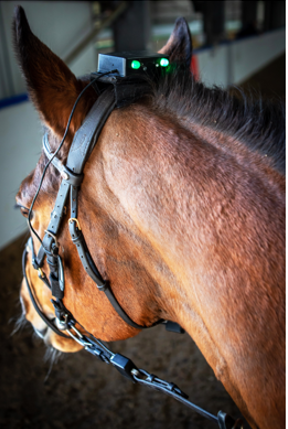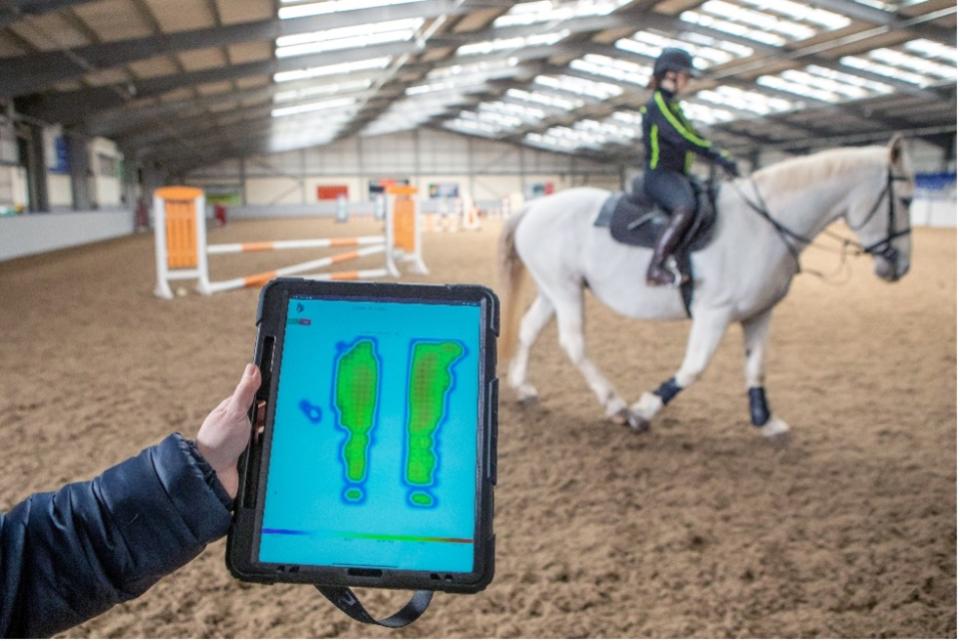Students enrol on to equine courses because they have a passion for horses. This doesn’t always mean they know how to ride a horse. Students often come with no prior riding experience or with “bad riding habits” that have been formed through unawareness and repetition over time.
Learning to ride horses takes time and is steeped in traditional methods of teaching. Instructors often stick to these traditional approaches because they are seen to be the main way students learn. However, these methods are not effective for all participants, and those with challenges in learning often struggle to understand and build their skills.
In response, we have developed an innovative way of using technology that challenges these historic and limited learning environments. Though we’re working in a niche field, how we have used technology to create a more inclusive learning environment for riders, regardless of their background and experience, holds lessons for all educators.
Tracking cameras
The Pixio Robot Camera System has auto-follow capabilities for moving objects that track the rider as they go around the arena. It allows riders to review their performance and see what the instructor sees (which they commonly do not feel in themselves). The rider can also see the impact this is having on the horse and correct their fault(s) for the welfare of the animal. A series of recordings can be used to track progress over time and relevant exercises set for the rider to work on independently.
Saddle pressure mat
To give students a more in-depth understanding of the impact the rider’s position has on the horse, we use the Estride Harmony saddle pressure mat. It is placed on the horse’s back and under the saddle. It downloads data from 920 pressure points to an app and displays in colour where the most pressure is on areas of the back.
This pressure mat can be used for teaching saddle fitting and for riding pressure. When the rider perhaps sits crooked in the saddle, the pressure mat will highlight the uneven weight on the horse’s back, which if uncorrected will lead to pain for the horse and uneven muscle development. It can also have long-term impacts on the rider’s strength and muscle development, and potentially lead to problems in the future.
Biometric jackets and symmetry markers
We also incorporate the Centaur Biomechanics mesh training jackets and symmetry markers in our coaching sessions. These provide highlighted lines desired for the classical position to help promote and develop a correct riding position. With the robot camera system and saddle pressure mat, this addition makes it even clearer for the rider to evaluate their own position when riding and when jumping.
Rein-pressure sensors
Another area that significantly affects the horse’s performance is the connection between the rider’s hands and the bit in the horse’s mouth. The amount of connection through the rein will vary among horses but a common fault in riders is stiff and poorly positioned hands, elbows and shoulders. A rein-pressure sensor system helps the rider to understand more about the amount of pressure on the left and right side of the horse. This very useful device has a box that sits on top of the horse’s head and has two lights that indicate the left and right rein. The lights are on a colour-coded system and change with the pressure applied by the rider on the horse’s mouth. The feedback to the rider is instant and they are in control of adjusting themselves.
For nervous riders it is a place to focus their attention and can be a subconscious distraction.

Position monitors
We use Nagga, a small jocularly named device that is calibrated to buzz or beep if the rider enters the parameters of incorrect positioning. It can be fitted to the rider’s hat to aid those riders who look down when riding, fitted to the rider’s wrist for those who drop the hand too low or too high and on the ankle for riders who raise the heels when riding. In any of these positions, the device gives instant feedback to the rider and promotes self-correction. All these positional faults make the rider stiff and unbalanced, with effects on the way they and their horse will perform.
Getting the basics of classical seat riding right is imperative for success in equine science, and this technology makes that achievement available to more students at a reasonable cost to the university. These devices can be used on their own or with a combination depending on the needs of the individual, their learning styles or their experience. And in supporting riders we’re improving horses’ welfare.
Our experience shows the value of using technology to break down the barriers of a traditional learning approach so that it is more inclusive. These technologies could also be adopted for the evaluation of a range of practical learning situations, including for the development of positioning in sports or physical performance evaluations. It opens the options for diversity of learning, and with this comes inclusivity.
Jennifer Fitzpatrick is an equine lecturer at Scotland’s Rural College
Scotland’s Rural College (SRUC) has been shortlisted for Technological or Digital Innovation of the Year at the Times Higher Education Awards 2023 #THEAwards. See the full list of shortlisted candidates. Winners will be announced at a ceremony on 7 December in Liverpool.
Academics and university leaders from across the UK and Ireland will come together that week at THE Campus Live UK&IE to talk about institutional strategies, teaching and learning, the student experience and more. Join us for this two-day event in Liverpool.
If you would like advice and insight from academics and university staff delivered direct to your inbox each week, sign up for the Campus newsletter.




comment